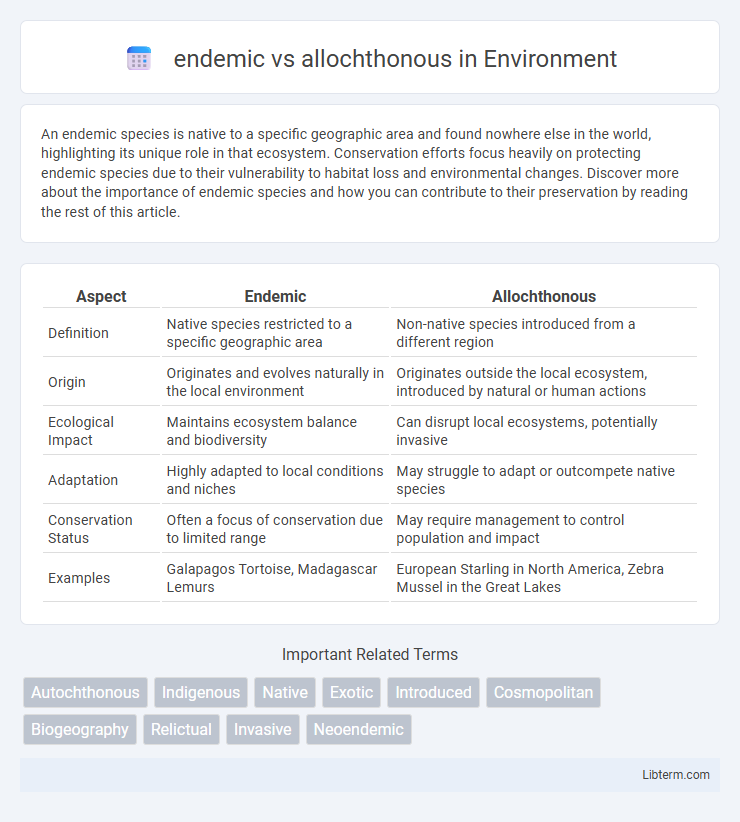An endemic species is native to a specific geographic area and found nowhere else in the world, highlighting its unique role in that ecosystem. Conservation efforts focus heavily on protecting endemic species due to their vulnerability to habitat loss and environmental changes. Discover more about the importance of endemic species and how you can contribute to their preservation by reading the rest of this article.
Table of Comparison
| Aspect | Endemic | Allochthonous |
|---|---|---|
| Definition | Native species restricted to a specific geographic area | Non-native species introduced from a different region |
| Origin | Originates and evolves naturally in the local environment | Originates outside the local ecosystem, introduced by natural or human actions |
| Ecological Impact | Maintains ecosystem balance and biodiversity | Can disrupt local ecosystems, potentially invasive |
| Adaptation | Highly adapted to local conditions and niches | May struggle to adapt or outcompete native species |
| Conservation Status | Often a focus of conservation due to limited range | May require management to control population and impact |
| Examples | Galapagos Tortoise, Madagascar Lemurs | European Starling in North America, Zebra Mussel in the Great Lakes |
Defining Endemic and Allochthonous: Key Concepts
Endemic species are native organisms restricted to a specific geographic area, evolving naturally within that region without external influence. Allochthonous species originate outside the local ecosystem and are introduced through external processes such as migration, human activity, or environmental changes. Understanding these concepts is crucial for ecological studies, biodiversity conservation, and managing invasive species.
Geographic Distribution: Where Do They Occur?
Endemic species are native to and restricted within specific geographic regions, such as islands, mountain ranges, or isolated ecosystems, where they have evolved unique adaptations. Allochthonous species originate outside the region in question and are introduced through natural migration or human activities, often leading to non-native populations across diverse habitats globally. Endemic populations are typically limited to localized areas, while allochthonous species can spread widely beyond their indigenous ranges, influencing global biodiversity patterns.
Origins and Evolutionary History
Endemic species originate and evolve within a specific geographic region, often adapting uniquely to local environmental conditions over long periods, which results in high levels of specialization and genetic divergence. Allochthonous species, in contrast, originate outside the region they currently inhabit, often arriving through dispersal mechanisms such as wind, water, or human activity, and may exhibit less specialized adaptations to the new environment. The evolutionary history of endemic species is typically marked by isolation and speciation events, while allochthonous species reflect more recent migration and introduction dynamics influencing biodiversity patterns.
Ecological Roles and Functions
Endemic species contribute to ecological stability by fulfilling specialized roles within their native ecosystems, often maintaining nutrient cycling and habitat structure. Allochthonous species introduce external energy and organic matter, fueling food webs and supporting diverse trophic interactions in recipient ecosystems. Both types influence ecosystem resilience, with endemic species promoting long-term equilibrium and allochthonous inputs driving seasonal or spatial nutrient dynamics.
Factors Influencing Endemic and Allochthonous Status
Factors influencing endemic and allochthonous status include geographic isolation, evolutionary history, and environmental conditions. Endemic species often evolve in isolated ecosystems with limited gene flow, resulting in unique adaptations to local habitats. In contrast, allochthonous species are introduced from external regions, driven by mechanisms such as human activity, natural dispersal, or habitat connectivity, impacting native biodiversity and ecosystem dynamics.
Examples Across Ecosystems and Continents
Endemic species such as the Galapagos giant tortoise in the Galapagos Islands and the lemurs of Madagascar thrive exclusively in their native ecosystems, demonstrating unique evolutionary adaptations. In contrast, allochthonous species like the zebra mussel in North American freshwater systems and the European starling in Australia have been introduced, often altering local biodiversity and ecosystem functions. These examples across continents highlight the ecological significance of geographic origin in shaping species interactions and environmental balance.
Impacts on Biodiversity and Conservation
Endemic species, confined to specific geographic areas, often have specialized habitat requirements that make them highly vulnerable to environmental changes and habitat loss, thereby significantly impacting local biodiversity conservation efforts. Allochthonous species, introduced from outside ecosystems, can disrupt native communities through competition, predation, or disease transmission, frequently leading to declines in endemic populations and altering ecosystem functions. Effective biodiversity conservation strategies require understanding the balance between protecting endemic species while managing the ecological risks posed by allochthonous species invasions.
Threats and Vulnerability: Endemic vs Allochthonous Species
Endemic species face high extinction risks due to their limited geographic ranges and specialized habitat requirements, making them vulnerable to habitat loss, climate change, and invasive species. Allochthonous species, introduced from external environments, can threaten endemic populations by outcompeting native species, spreading diseases, and altering ecosystem dynamics. Conservation strategies must prioritize protecting endemic species' habitats while managing allochthonous species to reduce ecological imbalance and biodiversity loss.
Human Influence and Habitat Change
Endemic species, confined to specific geographic areas, face heightened vulnerability due to human-induced habitat destruction, fragmentation, and urbanization, which directly reduce their natural habitats. Allochthonous species, often introduced by human activities like trade and transportation, can disrupt native ecosystems by competing with endemic species and altering habitat structure. Human influence accelerates these processes, intensifying habitat change and shifting species distributions through invasive species introductions and environmental modifications.
Future Perspectives and Research Directions
Future perspectives in studying endemic and allochthonous species emphasize advanced genomic tools to unravel evolutionary histories and adaptive traits. Research directions prioritize integrating ecological modeling with climate change scenarios to predict species distribution shifts and potential invasions. Conservation strategies increasingly focus on habitat restoration and monitoring genetic diversity to maintain ecosystem resilience amid anthropogenic pressures.
endemic Infographic

 libterm.com
libterm.com